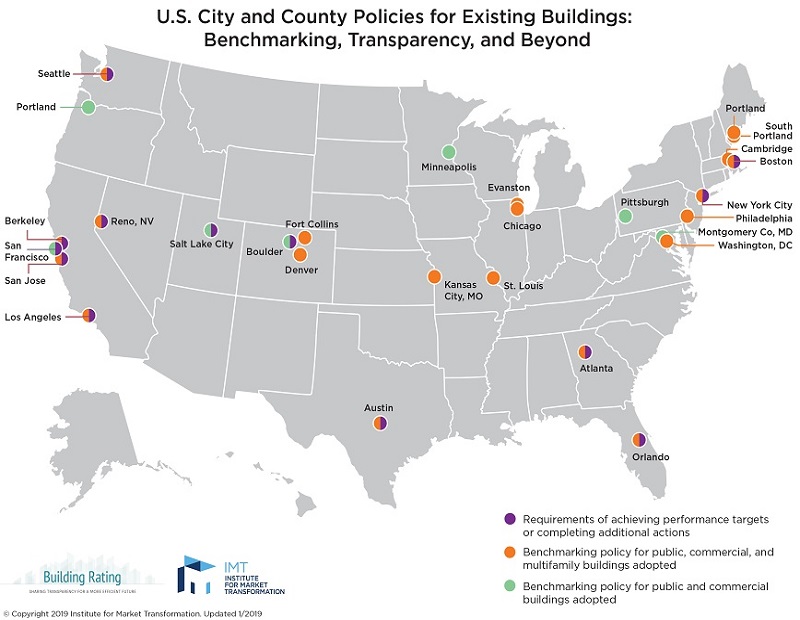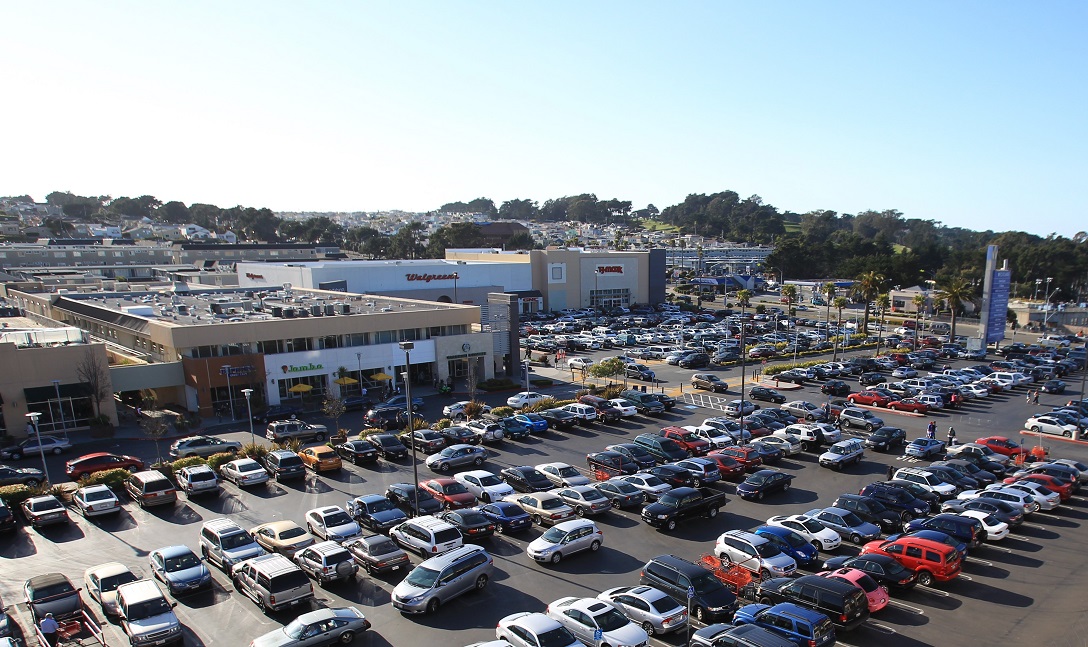5 Reasons Owners Should Take the Lead on Submetering
Improved building performance and financial benefits will result from the effort, contends a new study by the Institute for Market Transformation.

Map courtesy of the Institute for Market Transformation
Submetering has evolved greatly since the days when it was a time-consuming process with hardware that required a person to physically record data from a dial to a spreadsheet. Today’s sophisticated cloud-based wireless devices are more affordable and they churn out real-time data to a dashboard with analytics overlaid that can identify problems.
Unfortunately, despite these advances, submetering is too expensive or impractical for many typical commercial and retail tenants. That’s why landlords are best positioned to lead the way on commercial building energy management, according to the Landlord-Tenant Energy Partnership—an initiative led by the Institute for Market Transformation (IMT), the International Council of Shopping Centers (ICSC) and the Retail Industry Leaders Association (RILA).
Sharing results from a deep dive into the topic, the Landlord-Tenant Energy Partnership has released “Why Landlords Should Take the Lead On Installing Submeter Technology,” a report written by Audi Banny, associate director of private sector engagement at the Institute for Market Transformation (IMT) and former Director of Corporate Sustainability Initiatives for Estee Lauder Companies. IMT’s research identified these benefits that landlords will reap by investing in submeters for their tenant spaces:
- Create transparency and accountability to promote building efficiency practices. “Imagine if you were to reshape energy consumption data and awareness to be more symbiotic in the way the building is operated,” says Banny. Vornado Realty Trust is doing exactly that. Across the company’s New York City portfolio, each Vornado tenant is submetered, has access to view its energy consumption, and can learn how to apply simple operational measures to reduce consumption and save money. As Vornado communicates the value of the data with their tenants, it’s able to influence energy consumption behavior.
- Provide cost certainty and better energy measurement and verification. Today’s submeters are designed to predict issues before they occur. Automated submeters can actually help building operators ensure energy isn’t wasted during scheduled non-working hours. By collaborating with tenants on an integrated whole-building submetering solution, the landlord can recoup energy costs by billing tenants for their actual energy use.

Audi Banny Photo: Institute for Market Transformation
- Predict systems and equipment failure before they occur. Real-time submeters provide users data on equipment that goes beyond knowing if the equipment is on or not. By evaluating how much energy is consumed, the data can inform whether or not a piece of equipment is functioning correctly or may need servicing or replacement. According to Banny, “Submetering can also support fault detection diagnostics and predictive maintenance to identify issues prior to failure such as overheating or leaking systems. This equates to less equipment down time and fewer calls from unhappy tenants.”
- Motivate tenants to reduce energy use. Tenants consume a vast amount of energy in buildings. For example, plug and process loads such as computers and other devices account for 33 percent of an office building’s energy consumption and is projected to increase 49 percent by 2030, according to the National Renewable Energy Lab. Information gained from submetering combined with smart tenant engagement strategies increases occupant awareness about easy-to-adopt energy-saving actions, and contribute towards whole-building energy savings.
- Future-proof buildings. Much of the existing building performance legislation across the U.S. requires landlords to track and report building performance data via the EPA’s free ENERGY STAR Portfolio Manager tool. Submetering allows landlords to provide more accurate whole-building data. More recently, the EPA developed ENERGY STAR for tenants, a performance-based recognition for occupied tenant spaces. ENERGY STAR for tenants provides a framework for collecting submetered data and offers best practice resources to substantially reduce operational cost savings. So far, 39 tenants and landlords have received recognition in the ENERGY STAR for tenants charter program which ended last summer.
As cities adopt more aggressive building energy performance policies to meet their climate goals, landlords will need access to energy usage data to comply. Submeter-specific regulations have already been passed in New York City and San Francisco, where each city has implemented a submetering ordinance requiring non-residential buildings greater than 25,000 square feet to install submeters for any tenant space greater than 2,550 square feet in San Francisco and 5,000 square feet in New York.
“Tenants are getting wiser,” says Banny. “They’re recognizing they could be asking the broker about a building’s energy star score—and they may not want to lease in a building that’s not efficient. This report is somewhat a plea to landlords to recognize the desire from their tenants who have a need for data transparency,” says Banny.
“The report was designed to foster the opportunities to engage that tenant, to help them make the right decisions to make their spaces as efficient as possible either from [time of] the lease signing or mid lease. Additionally, it’s better to have one whole system in a building than a hodgepodge of technology doing virtually the same thing, but not really working together,” according to Banny.

Westlake Shopping Center, Daly City, Calif. Photo by Jed Jacobsohn, courtesy of Kimco Realty Corp.
Kimco Realty Corp., one of the largest owners of open-air shopping centers in the U.S., installed submeters in most of its 8,500 leased tenant spaces. Kimco was able to save millions of dollars in improved cost recovery as a landlord by incorporating green lease language that allowed it to share the cost of improvements with its tenants. According to Will Teichman, senior director of strategic operations for Kimco, the REIT was able to pursue its submetering program by deploying capital on behalf of its tenants and amortizing the cost for connectivity and IT equipment.
“The green lease is here, and it’s here to stay. Ten years from now most commercial leases will have green elements in them,” observes Teichman. Kimco’s green lease includes clauses that allow the company to submeter most of its tenant spaces while saving millions of gallons of water and achieving millions of dollars in improved cost recovery as a landlord. Aligning the tenant incentive, the customer is only billed on what they actually use. Submeters typically cost $1,500 to $2,000 apiece, including installation. Submeter costs are passed through to existing tenants or included as a tenant improvement for new tenants.
Teichman adds, “Anecdotally we’ve had very positive feedback from tenants in terms of that change. It’s a tangible example of how the combination of a green lease with some proactive retrofit programs—in this case adding submeters—has really been able to align in the interest of all parties landlord and tenants and result in improved outcome for everybody.”







You must be logged in to post a comment.